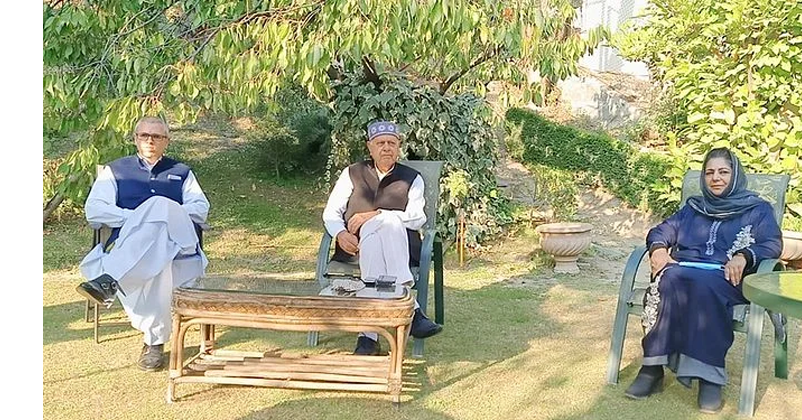In delimitation, more equitable assembly, LS segments emerge
| 16-Feb-2022 |

By Sant Kumar Sharma
All Kashmir-based parties – National Conference, Peoples Democratic Party, Peoples Conference and Jammu Kashmir Apni Party – have uniformly opposed draft recommendations of Delimitation Commission. These recommendations have broadly suggested rationalisation of territorial boundaries of most of the legislature seats, be they of the legislative assembly or the Lok Sabha. An interesting thing that emerges on a perusal of the accusations from Kashmiri leaders is that they have levelled vague charges not based on facts and hard figures.
Let us talk of the areas and voters in the five Lok Sabha seats during 2014 general elections and the lopsided distribution would become clear to us. The Jammu region was spread over 26,293 sq km ad the Kashmir region was at least 10,000 sq km smaller at 15,948 sq km. In terms of voters, Jammu Lok Sabha seat had 20,05,734 voters, Udhampur Lok Sabha seat 16,65,489 voters, Srinagar 12,93,935 voters, Anantnag 13,93,740 voters and Baramullah 13,12,148 voters.
Areawise, Udhampur Lok Sabha seat was the largest spread over 18,892 sq km, Jammu Lok Sabha seat over 7,401 sq km, Srinagar 3,599 sq km, Anantnag 5,282 sq km and Baramullah 6,967 sq km. On a perusal of these figures, it becomes clear that the two Lok Sabha constituencies in the Jammu region were far, far bigger in terms of geographical spread as also voterwise compared to the three Lok Sabha segments.
What the Delimitation Commission headed by Justice (retired) Ranjana Prakash Desai has done is altered the boundaries of all five Lok Sabha segments so that there is rationalisation in terms of geographical spread as also voters. That is the reason for inclusion of Rajouri (except one assembly segment) and Poonch districts into Anantnag Lok Sabha seat. Earlier, the Udhampur Lok Sabha seat had as many as six districts namely 1. Kathua 2. Udhampur 3.Reasi 4. Doda 5. Kishtwar and 6. Ramban and Srinagar Lok Sabha seat only three 1. Srinagar 2. Ganderbal and 3. Budgam.
In terms of assembly segments, the Udhampur Lok Sabha seat had 20 seats while the Jammu Lok Sabha seat had 17 seats. The 46 seats in the Kashmir region were divided into three Lok Sabha segments and the distribution was absolutely lopsided. Now, all five Lok Sabha seats in the Union Territory of Jammu and Kashmir will have 18 assembly seats each. It is important to note here that for the purpose of delimitation, whole of UT is considered one unit. As is usual in common parlance, the two divisions of Kashmir region and the Jammu region are not considered two separate units by the Deimitation Commission.
Incidentally, the Rajouri district is spread over 2,630 sq km and Poonch over 1,674 sq km. After adding them to the Anantnag Lok Sabha segment will be 5,282+2,630+1,674= 9,584. However, some areas of Anantnag Lok Sabha segment have, however, been put in Srinagar Lok Sabha segment and the new LS segment will be less than 9,000 sq km. Earlier, Srinagar Lok Sabha segment was only 3,599 sq km and new areas of Pulwama 1,398 sq km and Shopian 612 sq km have been added to it. It will now become 3,599+1,398+612= 5,609 sq km (actually lesser).
Overall, we can see that the unusually large Jammu and Udhampur Lok Sabha segments have been made smaller, and the segments in the Kashmir have been made bigger. Incidentally, it is pertinent to mention here there has never ever been delimitation of Lok Sabha segments in Jammu and Kashmir. Another fact that needs to be mentioned here is that the first Lok Sabha elections were held in 1967 only. That means even in 1967, Udhampur Lok Sabha segment was 18,892 sq km and the largest Lok Sabha segment in Kashmir 50 years later is only less than 9,000 sq km. Even then, the Kashmir politicians are cribbing and complaining.
At the level of delimitation of assembly segments in the UT, six new segments have been added to the 37 seats in the Jammu region and one new segment in the Kashmir region. Just like the Lok Sabha segments, the assembly segments in the Jammu region were way too large as compared to those in the Kashmir region when the last assembly elections were held in 2014. Incidentally, there were 10 assembly segments with more than one lakh voters in the Jammu region and only four with over one lakh voters in Kashmir.
We need to mention here that the largest assembly segment was Gandhi Nagar in the Jammu region having 1,68,643 voters. The largest assembly segment in the Kashmir region was Batmaloo with 1,20,339 voters. The smallest assembly segment in the Jammu region was Bani having 41,506 voters while as the smallest assembly segment in the Kashmir region was Gurez with only 17,554 voters. The average number of voters in one assembly segment in the Jammu region was over 90,000 voters and the average number of voters in one assembly segment in the Kashmir region was only 81,000 voters.
In all the earlier assembly elections also, the average number of voters in an assembly segment in Jammu was far larger than those in the Kashmir region. The relevant figures for 2008, 2002 and 1996 assembly elections are also available on the website of the Election Commission of India (ECI). With the new delimitation, the distribution of voters in the assembly segments all over Jammu and Kashmir will be more homogenous and balanced.